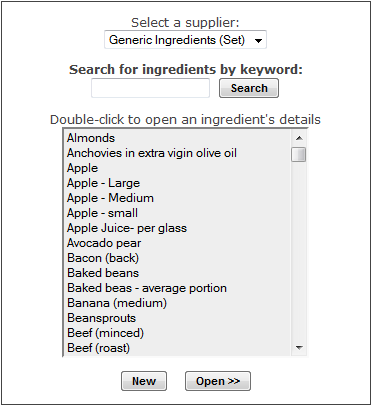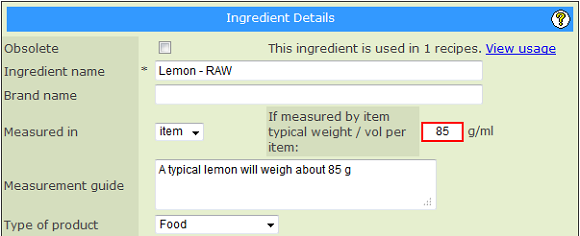

The ingredients page (Ingredients / Ingredients) is, without doubt, the longest single page in the system. This is not surprising since each ingredient has potentially an enormous amount of information about it. In broad terms, the information about an ingredient can be grouped into:
Before getting into the detail of an ingredient record though, a brief description of the left hand side of the Ingredients page.

Because there are many thousand ingredients in the system under various suppliers, the main selector will initially be empty. Once you select a supplier using the top drop-down list, or enter a keyword for searching, a list of ingredients will be displayed, as shown above.
You can then open the details of any of those ingredients by double-clicking on it, whereupon the details will be displayed in the boxes on the right hand side.
One note about the keyword search; it not only looks for the keyword you enter in the name of the ingredient, it also looks at the supplier product code so you can enter a product code and find the corresponding ingredient.
Now, onto the ingredients details. Firstly, the top section:

If an ingredient is ticked as Obsolete, any recipes that use the ingredient will NOT be affected, however you will receive a message informing you that you are using an obsolete ingredient, whereupon you should use the Recipes / Replace Ingredient option to replace it with a current ingredient.
Also, the number of recipes that the ingredient is used in is displayed. If you click on View Usage you will see a list of those recipes.
In the name and measurement section, shown above, the name and brand name are self-explanatory however the method of measurement is a little more tricky to understand.
The three options for "Measured in" are grm, ml and item and these relate to the way in which that ingredient is most likely to be used in a catering situation.
Note: ALL measurements of weight or volume used in the system are either grams or millilitres (mls). There is a handy converter (look for the "Converter" link) to help you move from traditional units of measurement (ounces, pounds, cups, tablespoons, etc.) to the metric scales.
For example, flour is likely to be used by weight, i.e. grams, whereas eggs are more likely to be used as items, e.g. 3 eggs.
NOTE: It is vital to make sure that you have this distinction clear in your mind. When you are adding ingredients to your recipes, depending on the ingredient measurement type, the quantity you must enter will either be an amount of weight, volume or a number of items. This is dependent on the way the ingredient has been defined on this page. The measurement type that has been defined is always shown at the end of the ingredient name in the drop-down list where you select it.
If an ingredient is to be measured by weight or volume then you select "grm" or "ml" in the "Measured In" drop-down list and that is all you need to do. If, however, the ingredient is to be measured in items, then you MUST also provide a typical weight for one of the items.
For medium eggs, for example, you select "item" in the Measured In drop-down list and then enter 50 in the "If measure by item, typical weight/vol per item" box.
The reason for this is that all nutrient content is provided "per 100g" of ingredient. Therefore, if you are adding one egg to a recipe, the system needs to know that you have actually added 50g of egg and it can therefore work out the actual amount of each nutrient being added to the recipe.
The Measurement Guide is a text box into which you can add any useful information about using the ingredient. This might say something like; one teaspoon = 10g. This information is displayed when you select an ingredient for adding to a recipe for your guidance.
The reason the measurement guide can be helpful is, for example, when you are adding a recipe you know that you always add two teaspoons of sugar to the mix. Now sugar is measured in grams so you must enter the number of grams into the recipe. The measurement guide would therefore help you to convert your two teaspoons of sugar into the 20g necessary to add to the recipe.
On the next pages the other sections on the ingredients page will be discussed.
|
|
|